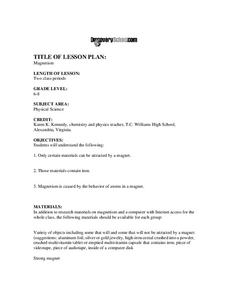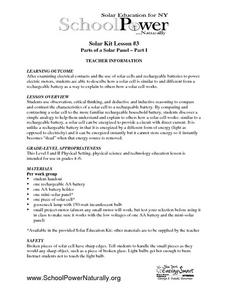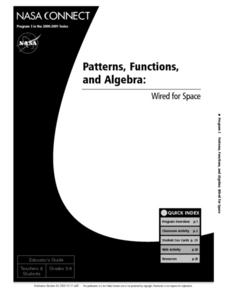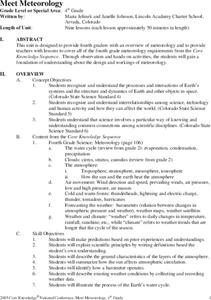Curated OER
The Strongest Pump of All
Students examine how the heart functions and the concept of how electrical currents can affect muscle contractions. In this cardiovascular lesson students identify P, QRS and T complexes.
Curated OER
Water Monitoring Vocabulary
As the title implies, this is a list of vocabulary terms relating to water monitoring. If your ecology class is learning about how to test water quality, this will be an appropriate reference sheet for them. As a bonus, if you live in...
Curated OER
Design Project: Voltmeter
In this physics worksheet, students design and build a multi-range voltmeter. They answer 3 short answer problems about the device.
Curated OER
Design Project: Power Inverter
In this physics worksheet, students design and build a power inverter given a schematic diagram. They answer 3 short answer questions about the circuit they created.
National Energy Education Development Project
Introduction to Wind Energy
The U.S. produced enough wind energy in 2015 to power all of the homes in Alaska, California, Delaware, the District of Columbia, Hawaii, Idaho, Maine, Montana, Nebraska, New Hampshire, North Dakota, Rhode Island, South Dakota, and...
Curated OER
Corrosion to Corals
Students study galvanic exchange and how it produces electric currents. In this ocean instructional activity students predict what metals deteriorate in salt water.
Curated OER
Solar Kit Lesson #13 Solarize a Toy
Young scholars work in teams they select a low-power toy, game, or electrical deive to "solarize," or convert to solar power. They determine the operating voltage of their chosen device and design a solar array to provide this level of...
Institute of Electrical and Electronics Engineers
Series and Parallel Circuits
Students demonstrate simple circuits and find the differences between parallel and serial circuits. For this electronic lesson plan students work in teams to test different designs using a low voltage light bulb.
Curated OER
Electromagnetic Pick-up
Students investigate electromagnetic energy. In this magnetism lesson, students will create an electromagnet and test changes with increased energy. They will compete by building the strongest electromagnet.
Curated OER
Science Lesson: Home-made Generator
Students are able to design and conduct an experiment related to electrical generation. They are able to list the factors that affect the amount of current that can be generated by a simple generator, such as the number of turns of...
Curated OER
Magnetism
Middle schoolers experiment with the concept of magnetism. Working in small groups, students design an experiment to test the magnet attraction of various substances. After completing their experiments, middle schoolers research...
Curated OER
Parts of a Solar Panel-Part I
Young scholars examine electrical contacts, solar cells, and rechargeable batteries and compare and contrast the characteristics of a solar cell to a rechargeable battery in a hands-on activity. Students complete a worksheet as they...
Curated OER
Patterns, Functions, and Algebra: Wired for Space
Learners assess how patterns, functions and algebra can assist NASA engineers design new ways of propelling spacecrafts. They explore how electricity and magnetism are replacing the fuel-consuming rocket propulsion. Electromagnetism is...
Curated OER
Series-Parallel DC Circuits Series and Parallel DC Circuits
In this electrical worksheet, students draw a schematic design and build a circuit board to grasp the understanding of series and parallel DC circuits before answering a series of 41 open-ended questions. Students interpret various...
Curated OER
Voltage Divider Circuits
In this physics worksheet, learners construct the circuit shown in the problem and calculate either voltage, current and resistance. They solve 37 circuit related questions.
Curated OER
Linear Computational Circuitry
In this electrical worksheet, students draw a schematic design circuit board to grasp the understanding amplification in linear circuitry before answering a series of 35 open-ended questions pertaining to a variety of linear circuitry....
Curated OER
Learning the Structure and Function of DNA
Students read about Humane Genome Project, examine structure and function of DNA, and participate in gel-electrophoresis lab. They complete Internet activity to test their knowledge of DNA.
Curated OER
Meet Meteorology
Students explore meteorology, discuss Earth's atmosphere, create drawings of the water cycle, create meteorology journals, and role play forecasters. Nine lessons on one page; includes unit test.
US Department of Energy
The Ring Fling Machine
Class members build a machine to demonstrate Lenz's law and help this scientific principle come to life. After building a ring fling machine, instructions for properly operating the machine and a few thought-provoking questions lead to...
US Department of Energy
The Invisible Electromagnet: A Transparent Magnetic Field Viewer
Audio speakers, hard drives, credit cards, and even the earth use magnetic fields. While we observe the effect of magnetic fields, we can't actually see them. A viewer helps participants explore magnetic fields, some of the items that...
Teach Engineering
Applications of Linear Functions
It's not so straightforward — lines can model a variety of applications. Pupils experience linear relationships within the context of science, including Hooke's and Ohm's Laws. Class members got a taste of motion and speed from the...
Teach Engineering
May the Magnetic Force Be with You
Class members use mathematics in order to better understand magnetic forces and their interaction on charged particles. After a demonstration of the interaction between a magnet and an electron beam using a CRT computer monitor,...
Curated OER
Insulators And Conductors
Students investigate the flow of electricity and how it effects different objects in the classroom as being classified as an insulator or conductor. They work in teams to test the conductivity of different classroom objects after making...
Curated OER
Magnets 1: Magnetic Pick-ups
Students are introduced to the power of magnets. In groups, they look at different objects and make predictions on whether they believe they are magnetic or not. They test their predictions and share their results with the class.

























